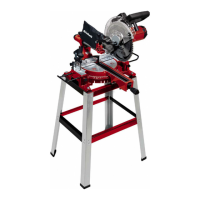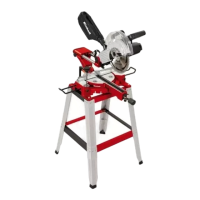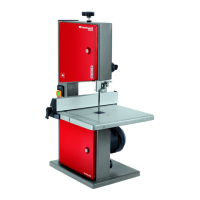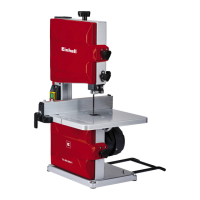GBGB
- 39 -
safety information.
Safety instructions
Danger! When using electric tools, basic sa-
fety precautions should always be followed
to reduce the risk of re, electric shock
and personal injury, including the following.
Read and follow these instructions before
using the equipment and keep the safety in-
formation in a safe place.
1. Keep work area clean
– Cluttered areas and benches invite injuries.
2. Consider work area environment
– Don‘t expose power tools to rain. Don‘t use
power tools in damp or wet locations. Keep
work area well lit. Don‘t use power tools in
presence of ammable liquids or gases.
3. Guard against electric shock
– Prevent body contact with grounded sur-
faces (e.g. pipes, radiators, ranges
refrigerators).
4. Keep children away
– Do not let visitors contact tool or extension
cord. All visitors should be kept away from
work area.
5. Store idle tools
– When not is use, tools should be stored in
dry, high, or locked-up place, out of the reach
of children.
6. Don‘t force tool
– It will do the job better and safer at the rate
for which it was intended.
7. Use right tool
– Don‘t force small tools or attachments to do
the job of heavy duty tool. Don‘t use tools for
purposes not intended: for example, don‘t use
circular saw for cutting tree limbs or logs.
8. Dress properly
– Do not wear loose clothing or jewelry. They
can be caught in moving parts. Rubber gloves
and nonskid footwear are recommended
when working outdoors. Wear protective nair
covering to contain long hair.
9. Use safety glasses
– Also use face or dust mask if cutting opera-
tion is dusty.
10. Don‘t abuse cord
– Never carry tool by cord or yank it to discon-
nect it from receptacle. Keep cord from heat,
oil and sharp edges.
11. Secure work
– Use clamps or a vise to hold work. It‘s safer
than using your hand and it frees both hands
to operate tool.
12. Don‘t overreach
– Keep proper footing and balance at all
times.
13. Maintain tools with care
– Keep tools sharp and clean for better and
safer performance. Follow instructions for
lubricating and changing accessories. Inspect
tool cords periodically and, if damaged, have
repaired by authorized service facility. Inspect
extension cords periodically and replace if
damaged. Keep handles dry, clean and free
from oil and grease.
14. Disconnect tools
– When not in use, before servicing, and
when changing accessories such as blades,
bits and cutters.
15. Remove adjusting keys and wrenches
– Form the habit of checking to see that keys
and adjusting wrenches are removed from
tool before turning it on.
16. Avoid unintentional starting
– Don‘t carry plugged-in tool with nger on
switch. Be sure switch is o when plugging in.
17. Outdoor use extension cords
– When tool is used outdoors, use only exten-
sion cords intended for use outdoors and so
marked.
18. Stay alert
– Watch what you are doing. Use common
sense. Do not operate tool when you are tired.
19. Check damaged parts
– Before further use of the tool, a guard or
other part that is damaged should be care-
fully checked to determine that it will operate
properly and perform its intended function.
Check for alignment of moving parts, binding
of moving parts, breakage of parts, mounting,
and any other conditions that may aect its
operation. A guard or other part that is dama-
ged should be properly repaired or replaced
by an authorized service center unless other-
wise indicated elsewhere in this instructions
manual. Have defective switches replaced by
an authorized service center. Do not use tool
if switch does not turn it on and o.
20. Warning
– The use of any other accessory or attach-
ment other than recommended it this ope-
rating instruction or the Einhell catalog may
present a risk of personal injury.
21. Have your tool repaired by an expert
– This electric appliance is in accordance with
the relevant safety rules repairing of electric
appliances may be carried out only by experts
otherwise it may cause considerable danger
for the user.
22. Connect the dust extraction device
Wherever there are facilities for tting a dust
extraction system, make sure it is connected
and used.Special safety information
1. Safety precautions
•
Blades that are deformed or cracked must not
be used.
•
If the table insert is worn, replace it.
•
Use only blades which are recommended by
the manufacturer and comply with EN 847-1.
•
Make sure that the chosen blade is suitable
for the material that is to be cut.
•
If necessary, wear suitable personal protec-
tion equipment. This could consist of:
- Ear plugs to prevent the risk of damaging
your hearing
- A breathing mask to avoid the risk of inha-
ling hazardous dust
- Always wear gloves when handling saw
blades and rough materials. Whenever
practicable, saw blades must be carried in a
container.
•
The following can have an influence on dust
development:
- Worn, damaged or cracked saw blades
- Recommended capacity of the vacuum ex-
traction system: 20 m/s
- Proper guidance of the workpiece
•
Blades made of high-alloy high-speed steel
(HSS) must not be used.
•
Keep the push stick or handle for a push
block at the machine at all times, even when
you are not using them.
2. Maintenance and service
•
The following conditions can have an influ-
ence on noise impact on the operator:
- Type of saw blade (e.g. saw blades de-
signed to reduce noise development)
- Material of the workpiece
- The force with which the workpiece is
pushed against the saw
•
Faults on the machine or its guards, safety
devices and blade must be reported to the
person in charge as soon as they are disco-
vered.
Anl_TC_SM_2531_2_U_SPK8.indb 39Anl_TC_SM_2531_2_U_SPK8.indb 39 30.06.2021 08:18:5930.06.2021 08:18:59
